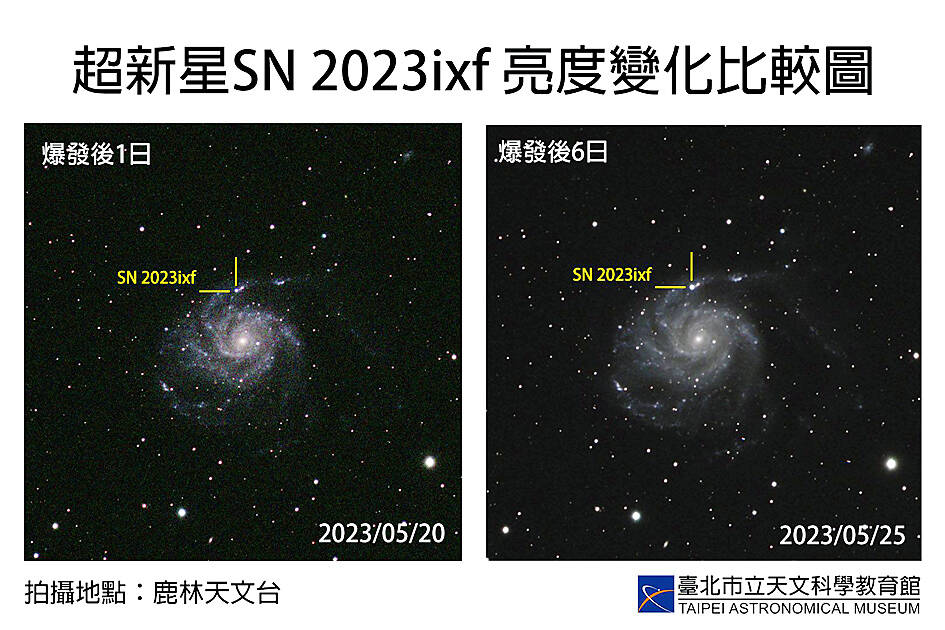A recently discovered supernova is the brightest and closest to Earth identified in the past decade, and can be observed with basic equipment, the Taipei Astronomical Museum said on Wednesday.
The supernova has an absolute magnitude of 14.9 in luminosity and is in the Pinwheel Galaxy (M101) about 21 million light-years from Earth.
It was discovered early on May 20 by Japanese amateur astronomer Koichi Itagaki, who immediately reported the finding to the International Astronomical Union, the museum said.

Photo courtesy of the Taipei Astronomical Museum
The supernova was designated SN 2023ixf following the astronomical naming conventions for supernovas, it added.
The museum said that it observed the supernova with a 5cm astronomical telescope at National Central University after receiving the news, and captured images of it with an exposure time of two minutes to analyze its brightness.
The supernova was created after the catastrophic destruction of a supergiant star, it said.
It is the brightest supernova discovered in a decade, it said, adding that the previous brightest supernova that was discovered was SN2014J in 2014.
People can observe the supernova with a small telescope, if the sky is clear and they are away from light sources, the museum said.
Observers around the world have been sharing the images they have taken, it said.
However, it could be a challenge for people to view the supernova with the naked eye or take clear pictures of it, as that would depend on the quality of photographic equipment used and the person’s experience, it said.

Taipei and New Taipei City government officials are aiming to have the first phase of the Wanhua-Jungho-Shulin Mass Rapid Transit (MRT) line completed and opened by 2027, following the arrival of the first train set yesterday. The 22km-long Light Green Line would connect four densely populated districts in Taipei and New Taipei City: Wanhua (萬華), Jhonghe (中和), Tucheng (土城) and Shulin (樹林). The first phase of the project would connect Wanhua and Jhonghe districts, with Chiang Kai-shek Memorial Hall and Chukuang (莒光) being the terminal stations. The two municipalities jointly hosted a ceremony for the first train to be used

The Mainland Affairs Council (MAC) yesterday said it is fully aware of the situation following reports that the son of ousted Chinese politician Bo Xilai (薄熙來) has arrived in Taiwan and is to marry a Taiwanese. Local media reported that Bo Guagua (薄瓜瓜), son of the former member of the Political Bureau of the Central Committee of the Communist Party of China, is to marry the granddaughter of Luodong Poh-Ai Hospital founder Hsu Wen-cheng (許文政). The pair met when studying abroad and arranged to get married this year, with the wedding breakfast to be held at The One holiday resort in Hsinchu

Tropical Storm Usagi strengthened to a typhoon this morning and remains on track to brush past southeastern Taiwan between Friday and Sunday, the Central Weather Administration (CWA) said. The storm, which as of 8am was still 1,100km southeast of southern Taiwan, is currently expected to enter the Bashi Channel and then turn north, moving into waters southeast of Taiwan, the CWA said. Because of its rapid speed — 28kph as of 8am — a sea warning for the storm could be issued tonight, rather than tomorrow, as previously forecast, the CWA said. In terms of its impact, Usagi is to bring scattered or

An orange gas cloud that leaked from a waste management plant yesterday morning in Taoyuan’s Guanyin District (觀音) was likely caused by acidic waste, authorities said, adding that it posed no immediate harm. The leak occurred at a plant in the district’s Environmental Science and Technology Park at about 7am, the Taoyuan Fire Department said. Firefighters discovered a cloud of unidentified orange gas leaking from a waste tank when they arrived on the site, it said, adding that they put on Level A chemical protection before entering the building. After finding there was no continuous leak, the department worked with the city’s Department